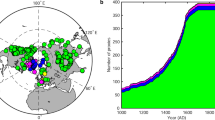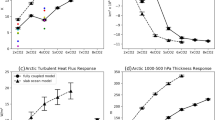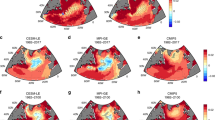Abstract
The driving mechanism of Arctic amplification (AA) is so complex that no consistent and definitive conclusion has been formed yet. In particular, the internally and externally driven trends of AA have not been distinguished using observation-based methods. Given that the Arctic is more sensitive than other regions to anthropogenic greenhouse gas increases and other external forcings, we focus on separating anthropogenically driven trends from the Arctic surface air temperature (SAT) changes during 1979–2017 to quantify the contribution of anthropogenic effects on AA, with detection and attribution converted to probability distribution functions. Results indicate that the Arctic coast of the Siberian Great Plains, from the Barents Sea to the Kara Sea and eastward to the Bering Strait, has been warming most significantly, and is mainly dominated by anthropogenically driven trends. From 1979 to 2017, the minimum anthropogenically driven warming in most parts of the Arctic Ocean exceeds 2℃, especially the Kara Sea area, where the anthropogenically driven warming is significant, reaching 4℃. In addition, the minimum anthropogenic contributions exceed 60% in most parts of the Arctic Circle and are more than 80% of the warming trend in (75–90° N, 150–180° W). In 140° W–140° E Arctic region, the anthropogenically driven trend is the most remarkable, at 0.82℃ / decade, accounting for 84.5% of the measured warming trend. Meanwhile, the anthropogenically driven trend accelerates most rapidly in this area (0–140° W, 60–90° N).










Similar content being viewed by others
Data availability
The NCEP-2 data are available for download: (https://psl.noaa.gov/data/gridded/data.ncep.reanalysis2.gaussian.html).
The ERA-Interim data analysed during the current study are from (http://apps.ecmwf.int/datasets/data/interim-full-daily/levtype=sfc/).
Code availability
Not applicable.
References
AMAP Assessment (2015) Black Carbon and Ozone as Arctic Climate Forcers. Arctic Monitoring and Assessment Programme (AMAP), Oslo, Norway, (2015) 116
Barnes EA, Polvani LM (2015) CMIP5 projections of Arctic amplification, of the North American/Northl Atlantic circulation, and of their relationship. J Clim 28:5254–5271
Bindoff NL, Stott PA, AchutaRao KM, Allen MR, Gillett N, Gutzler D, Hansingo K, Hegerl G, Hu Y, Jain S, Mokhov II, Overland J, Perlwitz J, Sebbari R, Zhang X (2013) Chapter 10-Detection and attribution of climate change: From global to regional. In: Climate change 2013: the physical science basis. IPCC Working Group I Contribution to AR5. Cambridge University Press, Cambridge
Bintanja R, Graversen RG, Hazeleger W (2011) Arctic winter warming amplified by the thermal inversions and consequent low infrared cooling to space. Nat Geosci 4:758–761
Bond TC, Doherty SJ, Fahey DW, Forster PM, Berntsen T, DeAngelo BJ, Flanner MG, Ghan S, K€archer B, Koch D, Kinne S, Kondo Y, Quinn PK, Sarofim MC, Schultz MG, Schulz M, Venkataraman C, Zhang H, Zhang S, Bellouin N, Guttikunda SK, Hopke PK, Jacobson MZ, Kaiser JW, Klimont Z, Lohmann U, Schwarz JP, Shindell D, Storelvmo T, Warren SG, Zender CS (2013) Bounding the role of black carbon in the climate system: a scientific assessment. J Geophys Res Atmos 118:5380e5552. https://doi.org/10.1002/jgrd.50171
Burt MA, Randall DA, Branson MD (2016) Dark warming. J Clim 29:705–719
Cai M (2005) Dynamical amplification of polar warming. Geophys Res Lett 32:L22710
Chen X et al (2019) Investigation of distribution, transportation, and impact factors of atmospheric black carbon in the Arctic region based on a regional climate-chemistry model. Pollution Environ. https://doi.org/10.1016/j.envpol.2019.113127
Cheng L et al (2017) Improved estimates of ocean heat content from 1960 to 2015. Sci Adv 3:e1601545. https://doi.org/10.1126/sciadv.1601545
Cohen J et al (2014) Recent Arctic amplification and extreme mid-latitude weather. Nat Geosci 7:627–637
Crook JA, Forster PM, Stuber N (2011) Spatial patterns of modeled climate feedback and contributions to temperature response and polar amplification. J Clim 24:3575–3592
Dai A, Luo D, Song M, Liu J (2019) Arctic amplification is caused by sea-ice loss under increasing CO2. Nat Commun 10:121. https://doi.org/10.1038/s41467-018-07954-9
Dee DP et al (2011) The ERA-Interim reanalysis: configuration and performance of the data assimilation system. Q J R Meteorol Soc 137:553–597. https://doi.org/10.1002/qj.828
Deser C, Terray L, Phillips AS (2016) Forced and internal components of winter air temperature trends over North America during the past 50 years: Mechanisms and implications. J Climate 29:2237–2258. https://doi.org/10.1175/jcli-d-15-0304.1
Ding Q, Schweiger A, L’Heureux M et al (2017) Influence of high latitude atmospheric circulation changes on summertime Arctic sea ice. Nat Clim Change 7:289–295
Ding Q, Wallace JM, Battisti DS et al (2014) Tropical forcing of the recent rapid Arctic warming in northeastern Canada and Greenland. Nature 509:209–212
Feldstein SB (2000) The timescale, power spectra, and climate noise properties of teleconnection patterns. J Climate 13:4430–4440. https://doi.org/10.1175/1520-0442(2000)013%3c4430:ttpsac%3e2.0.co;2
Feldstein SB (2002) The recent trend and variance increase of the annular mode. J Climate 15:88–94. https://doi.org/10.1175/15200442(2002)015%3c0088:trtavi%3e2.0.co;2
Feng C, Wu B (2015) Enhancement of winter arctic warming by the Siberian high over the past decade. Atmos-Ocean 8(5):257–263
Franzke C (2009) Multi-scale analysis of teleconnection indices: climate noise and nonlinear trend analysis. Nonlin Process Geophys 16:65. https://doi.org/10.5194/npg-16-65-2009
Franzke C (2010) Long-range dependence and climate noise characteristics of Antarctic temperature data. J Climate 23:6074–6081. https://doi.org/10.1175/2010jcli3654.1
Franzke C (2012) Nonlinear trends, long-range dependence, and climate noise properties of surface temperature. J Climate 25:4172–4183. https://doi.org/10.1175/jcli-d-11-00293.1
Franzke C, Woollings T (2011) On the persistence 367 and predictability properties of North Atlantic climate variability. J Climate 24:466–472. https://doi.org/10.1175/2010jcli3739.1
Franzke CLE, Lee S, Feldstein SB (2016) Evaluating Arctic warming mechanisms in CMIP5 models. Clim Dyn 48:3247–3260
Gong D, Zhou T, Wang S (2001) Advance in the studies on North Atlantic Oscillation (NAO). Adv Earth Sci 16(3):413–420
Gong T, Feldstein S, Lee S (2017) The role of downward infrared radiation in the recent Arctic winter warming trend. J Clim 30:4937–4949
Graversen RG, Langen PL, Mauritsen T (2014) Polar amplification in CCSM4: Contributions from the lapse rate and surface albedo feedbacks. J Clim 27:4433–4450
Hansen J, Sato M, Kharecha P, Von Schuckmann K (2011) Earth’s energy imbalance and implications. Atmos Chem Phys 11(24):13421–13449
Hemer MA, Wang XL, Weisse R, Swail VR (2012) Advancing Wind-Waves Climate Science: The COWCLIP Project. Bull Am Meteorol Soc 93:791–796. https://doi.org/10.1175/BAMS-D-11-00184.1
Holland MM, Bitz CM (2003) Polar amplification of climate change in coupled Models. Clim Dyn 21:221–232
Ikeda M (2012) Sea-ice cover anomalies in the Arctic Basin associated with atmospheric variability from multi-decadal trends to intermittent quasibiennial oscillations. Polar Res 31:18690. https://doi.org/10.3402/polar.v31i0.18690
IPCC (2013) Climate Change 2013: The Physical Science Basis. In Contribution of Working Group I to the Fifth Assessment Report of the Intergovernmental Panel on Climate Change. (eds Stocker TF et al) (Cambridge University Press, Cambridge)
IPCC (2019) Summary for Policymakers. In: Pörtner HO, Roberts DC, Delmotte VM, Zhai P, Tignor M, Poloczanska E, Mintenbeck K, Nicolai M, Okem A, Petzold J, Rama B, Weyer N eds, Climate change 2019: special report on the Ocean and Cryosphere in a Changing Climate. Cambridge University Press, Cambridge
Ishii M, Fukuda Y, Hirahara S, Yasui S, Suzuki T, Sato K (2017) Accuracy of global upper ocean heat content estimation expected from present observational data sets. Sola 13:163–167
Kanamitsu M et al (2002) NCEP-DEO AMIP-II reanalysis (R-2). Bull Am Meteorol Soc 83:1631–1643
Kantelhardt JW, Koscielny-Bunde E, Rego HA, Havlin S, Bunde A (2001) Detecting long-range correlations with detrended fluctuation analysis. Phys A 295:441–454. https://doi.org/10.1016/S0378-4371(01)00144-3
Law KS, Stohl A (2007) Arctic air pollution: origins and impacts. Science 315:1537. https://doi.org/10.1126/science.1137695
Lennartz S, Bunde A (2009) Trend evaluation in records with longterm memory: application to global warming. Geophys Res Lett 36(16). https://doi.org/10.1029/2009GL039516
Lennartz S, Bunde A (2011) Distribution of natural trends in long-term correlated records: a scaling approach. Phys Rev E 84(2):021129. https://doi.org/10.1103/PhysRevE.84.021129
Lennartz S, Bunde A (2012) On the estimation of natural and anthropogenic trends in climate records. Geophys Monogr 196:177–189. https://doi.org/10.1029/2011GM001079
Ludescher J, Bunde A, Franzke CLE, Schellnhuber HJ (2015) Long-term persistence enhances uncertainty about anthropogenic warming of West Antarctica. Clim Dyn 46:263–271. https://doi.org/10.1007/s00382-015-2582-5
Lu J, Cai M (2009) Quantifying contributions to polar warming amplification in an idealized coupled general circulation model. Clim Dyn 34:669–687
Madden RA (1976) Estimates of the natural variability of time-averaged sea-level pressure. Mon Wea Rev 104:942–952. https://doi.org/10.1175/1520-0493(1976)104%3c0942:eotnvo%3e2.0.co;2
Madden RA, Shea DJ (1978) Estimates of the natural variability of time-averaged temperatures over the United States. Mon Wea Rev 106:1695–1703. https://doi.org/10.1175/1520-0493(1978)106%3c1695:eotnvo%3e2.0.co;2
Park HS, Stewart A, Son JH (2017) Dynamic and thermodynamic impacts of the winter Arctic Oscillation on summer sea ice extent. J Clim 31(4):1483–1497
Peng C-K, Buldyrev SV, Havlin S, Simons M, Stanley HE, Goldberger AL (1994) Mosaic organization of DNA nucleotides. Phys Rev E 49:1685–1689
Pithan F, Mauritsen T (2014) Arctic amplification dominated by temperature feedbacks in contemporary climate models. Nat Geosci 7:181–184
Polyakov I, Walsh JE, Kwok R (2012) Recent changes of Arctic multiyear sea ice coverage and the likely causes. Bull Am Meteorol Soc 93:145–151
Polyakov IV, Pnyushkov AV, Alkire MB, Ashik IM, Baumann TM, Carmack EC, Goszczko I, Guthrie J, Ivanov VV, Kanzow T, Krishfield R, Kwok R, Sundfjord A, Morison J, Rember R, Yulin A (2017) Greater role for Atlantic inflows on seaice loss in the Eurasian Basin of the Arctic Ocean. Science 356(6335):285–291
Ramanathan V, Carmichael G (2008) Global and regional climate changes due to black carbon. Nat Geosci 1:221–227
Sand M, Berntsen TK, von Salzen K, Flanner MG, Langner J, Victor DG (2016) Response of Arctic temperature to changes in emissions of short-lived climate forcers. Nat Clim Chang 6:286. https://doi.org/10.1038/nclimate2880
Screen JA, Simmonds I (2010a) The central role of diminishing sea-ice in recent Arctic temperature amplification. Nature 464:1334–1337
Screen JA, Simmonds I (2010b) Increasing fall-winter energy loss from the Arctic Ocean and its role in Arctic temperature amplification. Geophys Res Lett 37:L16707
Serreze MC, Barrett AP, Stroeve JC, Kindig DM, Holland MM (2009) The emergence of surface-based Arctic amplification. Cryosphere 3:11–19
Serreze MC, Francis JA (2006) The Arctic amplification debate. Clim Change 76:241–264
Serreze MC et al (2007) The large-scale energy budget of the Arctic. J Geophys Res 112:D11122
Shindell DT, Chin M, Dentener F, Doherty RM, Faluvegi G, Fiore AM, Hess P, Koch DM, MacKenzie IA, Sanderson MG, Schultz MG, Schulz M, Stevenson DS, Teich H, Textor C, Wild O, Bergmann DJ, Bey I, Bian H, Cuvelier C, Duncan BN, Folberth G, Horowitz LW, Jonson J, Kaminski JW, Marmer E, Park R, Pringle KJ, Schroeder S, Szopa S, Takemura T, Zeng G, Keating TJ, Zuber A (2008) A multi-model assessment of pollution transport to the Arctic. Atmos Chem Phys 8:5353–5372
Spielhagen RF, Werner K, Sorensen SA et al (2011) Enhanced modern heat transfer to the Arctic by warm Atlantic water. Science 331(6016):450–453
Stohl A (2006) Characteristics of atmospheric transport into the Arctic troposphere. J Geophys Res Atmos 111:D11306. https://doi.org/10.1029/2005jd006888
Stroeve JC et al (2012) Trends in Arctic sea ice extent from CMIP5, CMIP3 and observations. Geophys Res Lett 39:L16502
Tamazian A, Ludescher J, Bunde A (2015) Significance of trends in long-term correlated records. Phys Rev: E 91. https://doi.org/10.1103/PhysRevE.91.032806
Taylor PC et al (2013) A decomposition of feedback contributions to polar warming amplification. J Clim 26:7023–7043
Thompson DWJ, Wallace JM (1998) The Arctic oscillation signature in the wintertime geopotential height and temperature fields. Geophys Res Lett 25(9):1297–1300
Wang M, Overland JE (2012) A sea ice free summer Arctic within 30 years: An update from CMIP5 models. Geophys Res Lett 39:L18501
Wang Y, Yan P, Ji F et al (2020) Unnatural trend of global land long-term surface air temperature change. Int J Climatol: 1–12. https://doi.org/10.1002/joc.6961
Wu B, Wang J, Walsh JE (2006) Dipole anomaly in the winter arctic atmosphere and its association with sea ice motion. J Clim 19(2):210–225
Yang Q, Bitz CM, Doherty SJ (2014) Offsetting effects of aerosols on Arctic and global climate in the late 20th century. Atmos Chem Phys 14:3969–3975. https://doi.org/10.5194/acp-14-3969-2014
Yim BY, Min HS, Kim BM et al (2016) Sensitivity of Arctic warming to sea ice concentration. J Geophys Res 121:6927–6942
Young I, Ribal A (2019) Multiplatform evaluation of global trends in wind speed and wave height. Science 364(6440):548–552
Yuan N, Ding M, Huang Y, Fu Z, Xoplaki E, Luterbacher J (2015) On the long-term climate memory in the surface air temperature records over antarctica: a nonnegligible factor for trend evaluation. J Clim 28(15):5922–5934. https://doi.org/10.1175/JCLI-D-14-00733.1
Zhang R (2015) Mechanisms for low-frequency variability of summer Arctic sea ice extent. Proc Natl Acad Sci U S A 112(15):4570–4575
Zhao J, Barber D, Zhang S et al (2017) Record low sea-ice concentration in the central Arctic during summer 2010. Adv Atmos Sci 35(1):106–115
Acknowledgements
We gratefully acknowledge the supports of the National Natural Science Foundation of China (41875096), the National Key Research and Development Program of China (2017YFC1502303), and the National Natural Science Foundation of China (42130610, 41875083, 41975091, 41905060).
Funding
This work was supported by the National Natural Science Foundation of China (41875096), the National Key Research and Development Program of China (2017YFC1502303), and the National Natural Science Foundation of China ( 42130610, 41875083, 41975091, 41905060).
Author information
Authors and Affiliations
Corresponding author
Ethics declarations
Conflict of interest
The authors declare no competing interests.
Additional information
Publisher's note
Springer Nature remains neutral with regard to jurisdictional claims in published maps and institutional affiliations.
Rights and permissions
About this article
Cite this article
Wang, Y., Yan, P., Feng, T. et al. Detection of anthropogenically driven trends in Arctic amplification. Climatic Change 169, 41 (2021). https://doi.org/10.1007/s10584-021-03296-6
Received:
Accepted:
Published:
DOI: https://doi.org/10.1007/s10584-021-03296-6




